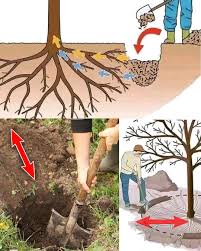Fertilizing trees is essential for their health and growth, but improper fertilization can waste resources and potentially harm the tree. This guide will help you understand the right techniques for fertilizing trees, ensuring they receive the necessary nutrients for optimal growth and development.
Understanding the Root System
Before fertilizing, it’s important to understand where a tree’s roots are most active. While the tree trunk may seem like the central point, the majority of a tree’s absorbing roots, including vital root hairs, spread out beneath the tree canopy, often extending beyond the drip line. These roots are crucial for nutrient uptake and should be the focus when fertilizing.
Step 1: Assessing the Need for Fertilization
Soil Testing:
The first step in proper fertilization is a soil test. This will identify which nutrients your tree is lacking, enabling you to choose the correct type of fertilizer.
Observation:
Look for signs of nutrient deficiency in the tree. Common indicators include discolored leaves, stunted growth, or early leaf drop. These symptoms suggest that your tree may need additional nutrients.
Step 2: Choosing the Right Fertilizer
Type:
Select a slow-release, granular fertilizer. This type ensures that nutrients are gradually made available to the tree over time, reducing the risk of over-fertilization.
Formula:
Choose a fertilizer with a balanced N-P-K (Nitrogen, Phosphorus, Potassium) ratio unless your soil test indicates a specific need. Nitrogen promotes leafy growth, phosphorus supports root development, and potassium helps overall plant health.
Step 3: Proper Fertilization Technique
Where to Fertilize:
Fertilize the area where the tree’s roots are most active, which is beneath the canopy and extending just beyond the drip line. Avoid placing fertilizer directly at the base of the trunk, as this is not where the roots are most effective.

How to Apply:
- Broadcast Method: Spread fertilizer evenly across the soil surface within the root zone, ensuring it’s distributed uniformly.
- Fertilizer Wells: For deeper nutrient penetration, create shallow wells (4-6 inches deep) around the drip line. Place the fertilizer directly into these wells to encourage deeper root absorption.
Watering:
After fertilizing, thoroughly water the area to help the nutrients move into the soil and become accessible to the roots. However, avoid allowing water to pool around the tree trunk, as this can lead to root rot.
Additional Tips for Tree Care
Watering Practices:
- Never let water touch the tree trunk directly. Use mulch or a dirt barrier to divert water away from the trunk.
- Overwatering or poor soil drainage can cause root rot. Ensure the soil drains well around your trees.
- In dry conditions, irrigate in intervals to avoid overhydration. Watering in smaller amounts but more frequently helps prevent waterlogging.
By understanding your tree’s root system, choosing the right fertilizer, and applying it properly, you can ensure that your tree thrives. Fertilizing correctly is about supporting the tree’s natural growth processes, creating an environment that nurtures its long-term health.
